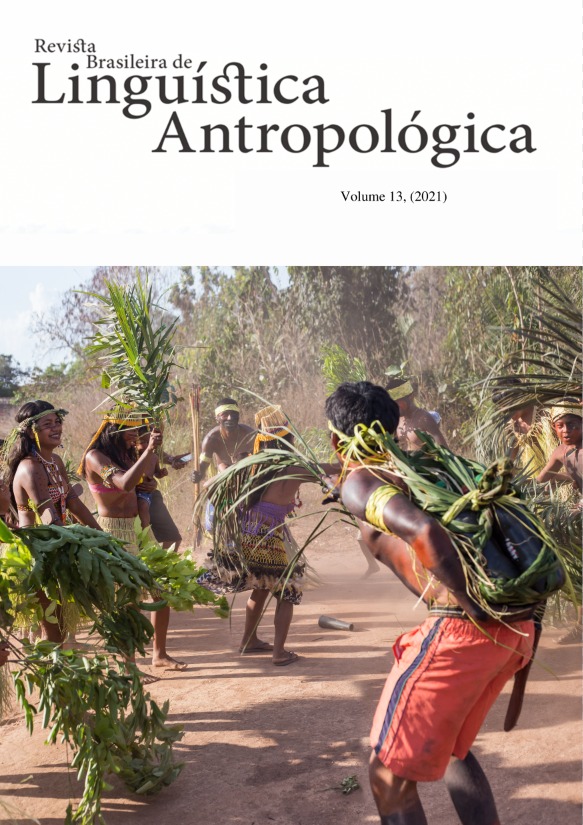Variation in the consonantal system of the Matis language (Panoan)
DOI:
https://doi.org/10.26512/rbla.v13i01.41415Keywords:
Variação consonantal, Nasalização, Sílaba, Língua Matis, Família PanoAbstract
The paper presents an analysis of the consonantal system in the Matis language. Based on the Matis phonological description, we aim to analyze whether labial, alveolar and velar voiced plosive consonants establish functional distinctions or are realized as phonetic features of nasal consonants. The research is based on the first descriptive studies on Matis phonology, and the data analyzed come from elicitation sessions and mainly from narratives collected in fieldwork. The results indicate that phonological processes of nasalization and resyllabification result in variation of consonants in the form post-oralized nasals. With the functional analysis of consonantal segments and variations based on the examination of the Matis consonantal system, we hope to advance the description of the phonological level of this language and collaborate in the definition of consonantal graphemes used in writing.
Downloads
References
Arisi, Barbara M. 2007. Matis e Korubo: contato e índios isolados no Vale do Javari, Amazônia. Dissertação de Mestrado, Universidade Federal de Santa Catarina, Florianópolis.
Arisi, Barbara M. 2011. A Dádiva, a Sovinice e a Beleza: economia da cultura Matis, Vale do Javari, Amazônia. Tese de Doutorado, Universidade Federal de Santa Catarina, Florianópolis.
Arisi, Barbara M. 2012. La No-Frontera Pano: etnónimos como categorías alternativas y múltiples entre Matis y Korubo. Tipití: Journal of the Society for the Anthropology of Lowland South America 10(1):19-36.
Barbosa, Raphael, A. O. 2020. Alinhamento morfossintático em Matis (Pano). Liames 2:1-17.
Barbosa, Raphael, A. O. 2021. Body-part morphemes in Matis (Panoan). Journal of Universal Language 22(1):65-90.
Erikson, Philippe. 2001. Myth and Material Culture: Matis Blowguns, Palm Trees, and Ancestor Spirits. Em Beyond the Visible and the Material: The Amerindianization of Society in the Work of Peter Rivière, 101-121. Oxford: Oxford University Press.
Erikson, Philippe. 2002. Several Fathers in One’s Cap: Polyandrous Conception among the Panoan Matis (Amazonas, Brazil). Em Cultures of Multiple Fathers: The Theory and Practice of Partible Paternity in South America, 123-136. Gainesville: University Press of Florida.
Erikson, Philippe. 2009. Obedient Things: Reflections on the Matis Theory of Materiality. Em The occult life of things: native Amazonian theories of materiality and personhood, 173-191. Tucson, University of Arizona Press.
Ferreira, Rogério V. 2001. Língua Matis (Pano): uma análise da morfossintaxe. Dissertação de Mestrado, Universidade Estadual de Campinas.
Ferreira, Rogério, V. 2005. Língua Matis (Pano): Uma Descrição Gramatical. Tese de Doutorado, Universidade Estadual de Campinas.
Ferreira, Rogério V. 2012. Aspectos tipológicos do switch-reference em línguas da Família Pano. Em Funcionalismo Linguístico: Análise e Descrição, 197-224. São Paulo: Contexto.
Ferreira, Rogério V. 2017. Concordância de participante em Matis (Pano). Amérindia 39:381-406.
Ferreira, Vitória, R. S. 2000. Língua Matis (Pano): Uma Análise Fonológica. Dissertação de Mestrado, Universidade Estadual de Campinas.
Ferreira, Vitória R. S. 2005. Estudo Lexical da Língua Matis: Subsídios para um Dicionário Bilíngue. Tese de Doutorado, Universidade Estadual de Campinas.
Fleck, David W. 2013. Panoan language and linguistics. Anthropological Papers of the American Museum of Natural History 99: 114p.
Keyser, Samuel, J. e Stevens, Kenneth, N. 2006. Enhancement and overlap in the spreech chain. Language 82:33-63.
La Grasserie, Raul de. 1889. De la famille linguistique Pano. Actas del VII Congreso Internacional de Americanistas:438-450.
Lanes, Elder J. 2005. Aspectos da Mudança Lingüística em um Conjunto de Línguas Amazônicas: As línguas Pano. Tese de Doutorado, Universidade Federal do Rio de Janeiro, Rio de Janeiro.
Matis, Bëux; Kuni Matis; Chapu Matis; Binã P. Matis; Tumi Matis; Mawi Matis; Ivã W. Matis; Makë B. Matis; Makë T. Matis; Pixi I. Matis e Binã M. Matis. 2005. Matsesën txu darawakit: palavras Matis. Centro de Trabalho Indigenista (CTI):97p.
Moore, Denny. 2008. Matis Databank. In Moseley, Christopher (ed.). 2010. Atlas of the World’s Languages in Danger, UNESCO Publishing. http://www.unesco.org/culture/en/endangeredlanguages/atlas.
Nascimento, Hilton. 2008. Matis. In Instituto Socioambiental, Povos Indígenas no Brasil. https://pib.socioambiental.org/pt/povo/matis.html.
Oliveira, Sanderson C. S. 2014. Contribuições para a reconstrução do protopáno. Tese de Doutorado, Universidade de Brasília, Brasília.
Ribeiro, Lincoln A. A. 2006. Uma proposta de classificação interna das línguas da família Pano. Revista Investigações. Lingüística e Teoria Literária 19(2):157-182.
UNESCO. 2012. Tximu bekte sinanek onkekin darawakid: falando sobre prevenção às DST/Aids e hepatites virais. Série Javari: educação preventiva para DST/HIV/Aids e hepatites virais para povos indígenas do Vale do Javari 3:67p.
Wetzels, Leo, W. e Nevins, A.. 2018. Prenasalized and postoralized consonants: the diverse functions of enhancement. Language 94(4):834-866.
Downloads
Published
How to Cite
Issue
Section
License
Copyright (c) 2021 Revista Brasileira de Linguística Antropológica

This work is licensed under a Creative Commons Attribution 4.0 International License.
Authors who publish in RBLA agree to the following terms:
a) Authors maintain the copyright and grant the journal the right of first publication, and the work is simultaneously licensed under the Creative Commons Attribution License, which allows the sharing of the work with recognition of the authorship of the work and initial publication in this journal.
b) Authors are authorized to assume additional contracts separately, for non-exclusive distribution of the version of the work published in this journal (eg, publish in an institutional repository or as a book chapter), with recognition of authorship and initial publication in this journal.
c) Authors are allowed and encouraged to publish their work online (eg, in institutional repositories or on their personal page) at any point before or during the editorial process, as this can generate productive changes, as well as increase impact and citation of the published work.







